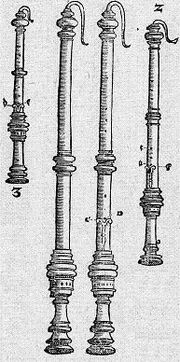
Bassanelli
Encyclopedia

Renaissance
The Renaissance was a cultural movement that spanned roughly the 14th to the 17th century, beginning in Italy in the Late Middle Ages and later spreading to the rest of Europe. The term is also used more loosely to refer to the historical era, but since the changes of the Renaissance were not...
double reed
Double reed
A double reed is a type of reed used to produce sound in various wind instruments. The term double reed comes from the fact that there are two pieces of cane vibrating against each other. A single reed consists of one piece of cane which vibrates against a mouthpiece made of metal, hardened...
woodwind instrument
Woodwind instrument
A woodwind instrument is a musical instrument which produces sound when the player blows air against a sharp edge or through a reed, causing the air within its resonator to vibrate...
which was described in 1619 by Michael Praetorius
Michael Praetorius
Michael Praetorius was a German composer, organist, and music theorist. He was one of the most versatile composers of his age, being particularly significant in the development of musical forms based on Protestant hymns, many of which reflect an effort to make better the relationship between...
in his Syntagma Musicum:
- "Bassanelli derive their name from the master who created them, Johann Bassano, an illustrious Venitian musician and composer. The bore of bassanelli is straight and opens at the bottom; and these instruments only have one key. They are blown by direct contact with the reeds, exactly as are curtals, pommers, and bassets, and are nearly the same as these instruments in timbre, but much softer. The cant, which is the littlest of the bassanelli, is notably excellent to hear on the tenor part in ensembles in which all types and sets of instruments are used, for its tuning is rather accurate, and is similar to flutes in the execution of a tenor part. With good reeds, bassanelli can be made to play rather high. Like shawms, they have seven fingerholes, with a key on the lowest. In the rear, however, there is no hole to be found. They are pitched a fourth lower than chamber pitch, for their lowest size is the bass in F, but in chamber pitch this is understood as the 8 foot C."
As there are no surviving examples of bassanelli, there is some disagreement concerning its construction, q.e. cylindrical versus conical bore
Bore (wind instruments)
The bore of a wind instrument is its interior chamber that defines a flow path through which air travels and is set into vibration to produce sounds. The shape of the bore has a strong influence on the instruments' timbre.-Bore shapes:...
.

